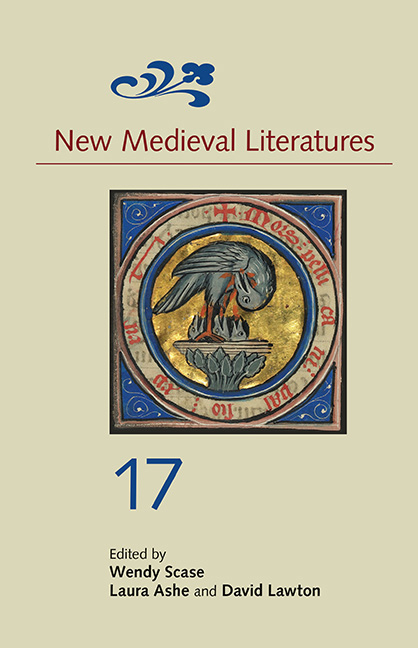Book contents
- Frontmatter
- Contents
- List of Illustrations
- 1 The Lives of Nytenu: Imagining the Animal in the Old English Boethius and Soliloquies
- 2 Disruptive Things in Beowulf
- 3 Pidgin Poetics: Bird Talk in Medieval France and Occitania
- 4 Performing Friendship in Richard Rolle's Incendium amoris
- 5 Damaged Goods: Merchandise, Stories and Gender in Chaucer's Man of Law's Tale
- 6 Gower's Bedside Manner
- 7 Vitreous Visions: Stained Glass and Affective Engagement in John Lydgate's The Temple of Glass
- 8 The Idle Readers of Piers Plowman in Print
2 - Disruptive Things in Beowulf
Published online by Cambridge University Press: 09 May 2017
- Frontmatter
- Contents
- List of Illustrations
- 1 The Lives of Nytenu: Imagining the Animal in the Old English Boethius and Soliloquies
- 2 Disruptive Things in Beowulf
- 3 Pidgin Poetics: Bird Talk in Medieval France and Occitania
- 4 Performing Friendship in Richard Rolle's Incendium amoris
- 5 Damaged Goods: Merchandise, Stories and Gender in Chaucer's Man of Law's Tale
- 6 Gower's Bedside Manner
- 7 Vitreous Visions: Stained Glass and Affective Engagement in John Lydgate's The Temple of Glass
- 8 The Idle Readers of Piers Plowman in Print
Summary
It is not normal today to think of ‘inanimate objects’ as possessing a lively capacity to do things to us and with us, although it is quite normal to experience them as such.
Jane Bennett, ‘The Powers of the Hoard’ (2012)When the spring comes to Friesland and the ice blocking the harbours finally thaws, a Danish thane brings his leader a powerful message, a call to violent and immediate action after a long, tense winter. Yet he does not do so through the powers of oratorical persuasion. Rather he makes a simple gesture: he places the sword of Hnæf, the Dane's fallen war-leader, onto the lap of his successor, Hengest, who responds by attacking his former hosts and avenging his predecessor's death. This is an intriguing moment within an Anglo-Saxon poetics that frequently creates drama through speeches and conversations – for example, in hagiographic narratives like Andreas or Guthlac A. However, in the scop's account of the fight at Finnsburh, the object is eloquent and compelling, and moves human actors to decision and response. Speech is substituted with the presence of an important relic of the slain lord. As Gillian Overing reminds us, a sword is a complex signifier culturally and linguistically, which can stand in for many things: battle, glory, political power, masculinity, even the man himself. In the case of the Danes in the Frisian springtime, this synecdoche, the sword, has been converted into a painful metaphor – the hildeleoma (the battle-bright blade) that remains when its owner has been taken away in death. And the fact of this final substitution demands swift, bloody action. By giving Hengest the symbolic authority over their expedition, the Danes have also given him responsibility for prosecuting the loss of Hnæf. The sword in this instance speaks in a louder and more irresistible voice than any human could – its unforgettable history of possession and inheritance calls out for savage retribution. And so the Danish warriors, with Hengest at their van, shatter the fragile truce and attack their former hosts. All because of the exchange of a sword. Objects in Beowulf can be perilous things.
This essay will explore the power of the so-called inanimate realm in Beowulf, and the para-subjective effects its things create within its milieu.
- Type
- Chapter
- Information
- New Medieval Literatures 17 , pp. 34 - 61Publisher: Boydell & BrewerPrint publication year: 2017



